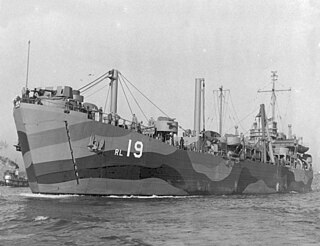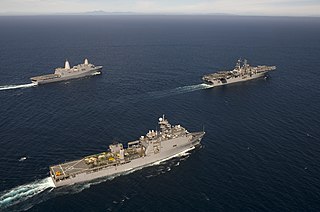| Hull no. | Ship | Keel laid | Launched | Commission | Decomm | Fate | Notes |
|---|
| ARL-1 | Achelous | 15 August 1942 | 25 November 1942 | 2 April 1943 | 1 January 1947 | Sold for scrapping | Originally ordered as LST-10 |
| ARL-2 | Amycus | 17 January 1943 | 2 April 1943 | 30 July 1943 | 15 November 1946 | laid up Pacific Reserve Fleet, Columbia River Group, 15 November 1946, sold for scrapping, 13 August 1971 | Originally ordered as LST-489 |
| ARL-3 | Agenor | 24 January 1943 | 3 April 1943 | 20 August 1943 | 15 November 1946 | transferred to France, through Mutual Defense Assistance Program, 2 March 1951; transferred to the Republic of China, 1957 | Originally ordered as LST-490 |
| ARL-4 | Adonis | 31 March 1943 | 14 June 1943 | 6 August 1943 | 11 October 1946 | Sold to private interest, 14 October 1960 | Originally ordered as LST-83 |
| ARL-5 | ARL-5 | 8 March 1943 | 28 May 1943 | 21 July 1943 | 19 July 1943 | Transferred to the Royal Navy, 29 July 1943, Sold to Argentina, 20 August 1947; Sold 1967 | Originally ordered as LST-81 |
| ARL-6 | ARL-6 | 25 March 1943 | 9 June 1943 | 26 July 1943 | 2 August 1943 | Transferred to the Royal Navy, 2 August 1943, Sold to Argentina, 20 August 1947; Sold into merchant service, 1968 | Originally ordered as LST-82 |
| ARL-7 | Atlas | 3 June 1943 | 19 October 1943 | 15 November 1943 | 13 September 1946 | Sold for scrapping, 18 September 1973 | Originally ordered as LST-231, Recommissioned: 1 June 1951 through 13 April 1956 |
| ARL-8 | Egeria | 19 June 1943 | 23 November 1943 | 30 March 1944 | 1 January 1947 | Sold for scrapping, 18 September 1973 | Originally ordered as "LST-136" |
| ARL-9 | Endymion | 23 August 1943 | 17 December 1943 | 9 May 1944 | 30 November 1946 | Sold for commercial service, 1 September 1973 | Originally ordered as LST-513 |
| ARL-10 | Coronis | 3 May 1944 | 8 June 1944 | 28 November 1944 | 29 July 1946 | Sold for commercial service, c. 1965 | Originally ordered as LST-1003 |
| ARL-11 | Creon | | 24 August 1944 | 28 November 1944 | 8 June 1949 | Unknown | Originally ordered as LST-1036 |
| ARL-12 | Poseidon | 10 July 1944 | 24 August 1944 | 13 February 1945 | 30 November 1946 | Unknown | Originally ordered as LST-1037 |
| ARL-13 | Menelaus | 17 November 1944 | 20 December 1944 | 29 May 1945 | 5 June 1947 | Laid up in the Atlantic Reserve Fleet, Green Cove Springs Group, Sold for commercial service, 28 October 1960 | Originally ordered as LST-971 |
| ARL-14 | Minos | 16 June 1944 | 15 September 1944 | 26 September 1944 | 18 June 1946 | Sold for scrapping, 18 October 1960 | Originally ordered as LST-644, Recommissioned: 22 September 1950 through 19 August 1955 |
| ARL-15 | Minotaur | 20 June 1944 | 20 September 1944 | 30 September 1944 | 26 February 1947 | Loaned to the Republic of Korea (1955), Fate: Unknown | Originally ordered as LST-645 |
| ARL-16 | Myrmidon | 25 August 1944 | 28 September 1944 | 9 March 1945 | 7 July 1947 | Sold, 21 December 1960 | Originally ordered as LST-948 |
| ARL-17 | Numitor | 19 September 1944 | 18 October 1944 | 3 April 1945 | 1 July 1947 | Sold, and converted to a drydock | Originally ordered as LST-954 |
| ARL-18 | Pandemus | 20 July 1944 | 10 October 1944 | 23 February 1945 | 23 September 1946 | Sunk as a target, 1969 | Originally ordered as LST-650, Recommissioned: 14 December 1951 through 30 September 1968 |
| ARL-19 | Patroclus | 22 September 1944 | 22 October 1944 | 17 April 1945 | 2 October 1946 | Transferred to Turkey, 15 November 1952, Scrapped, September 1993 | Originally ordered as LST-955 |
| ARL-20 | Pentheus | 29 September 1944 | 22 December 1944 | 7 June 1945 | 20 April 1946 | Sold, 13 June 1960 | Originally ordered as "LST-1115" |
| ARL-21 | Proserpine | 2 October 1944 | 28 December 1944 | 31 May 1945 | 18 January 1947 | Sold, 26 September 1960 | Originally ordered as LST-1116, Recommissioned: 27 October 1950 through 24 May 1956 |
| ARL-22 | Romulus | 17 October 1944 | 15 November 1944 | 10 May 1945 | 12 May 1947 | Laid up in the Pacific Reserve Fleet, Columbia River Group, Transferred to the Philippine Navy, November 1961, fate: unknown | Originally ordered as LST-962 |
| ARL-23 | Satyr | 16 August 1944 | 13 November 1944 | 27 November 1944 | 1 August 1947 | Transferred to South Vietnam, 30 September 1971, Transferred to the Philippines, 1975, scrapped, 2004 | Originally ordered as LST-852, Recommissioned: 8 September 1950 through 17 April 1956 and 15 February 1968 through 30 September 1971 |
| ARL-24 | Sphinx | 20 October 1944 | 7 March 1945 | 10 May 1945 | 26 May 1947 | Laid up in the Pacific Reserve Fleet, San Diego Group, Towed for scrapping, 1 December 2007 | Originally ordered as LST-963 Recommissioned: 3 November 1950 through 31 January 1956, Recommissioned: 16 December 1967 through 30 September 1971 and 26 July 1985 through 16 June 1989 |
| ARL-26 | Stentor | 21 September 1944 | 11 November 1944 | 22 December 1944 | 9 January 1945 | Sold for scrap, 23 January 1961 | Originally ordered as LST-858, Recommissioned: 28 April 1945 through 1 December 1947 |
| ARL-27 | Tantalus | 10 October 1944 | 2 January 1945 | 13 January 1945 | 18 January 1947 | Released to the Foreign Liquidation Commission for further transfer to the United Nations Relief, and Rehabilitation Administration for disposal, fate unknown. | Originally ordered as LST-1117 |
| ARL-28 | Typhon | 17 October 1944 | 5 January 1945 | 18 January 1945 | 30 April 1905 | Sold to private interest, 23 February 1961 | Originally ordered as LST-1118 |
| ARL-29 | Amphitrite | 6 November 1944 | 1 February 1945 | 28 June 1945 | 1 January 1947 | Sold, 16 April 1962 | Originally ordered as LST-1124 |
| ARL-30 | Askari | 8 December 1944 | 2 March 1945 | 15 March 1945 | 9 April 1945 | Sold to Indonesian Navy, 1971 | Originally ordered as LST-1131, Recommissioned: 23 July 1945 through 1 September 1971 |
| ARL-31 | Bellerophon | 12 December 1944 | 7 March 1945 | 19 March 1945 | 1 September 1947 | Sold for scrapping, 20 June 1980 | Originally ordered as LST-1132 |
| ARL-32 | Bellona | 27 December 1944 | 26 March 1945 | 28 July 1945 | 5 June 1946 | Grounded, 1 December 1945, Declared unsalvageable & destroyed with explosives, 14 May 1946 | Originally ordered as LST-1136 |
| ARL-33 | Chimaera | | 30 March 1945 | 7 August 1945 | 8 March 1948 | Unknown, Final Disposition, sold, 20 March 1962 to NASSCO, Terminal Island, San Pedro, CA | Originally ordered as LST-1137 |
| ARL-35 | Daedalus | 31 January 1945 | 27 April 1945 | 19 October 1945 | 23 October 1947 | Laid up in the Atlantic Reserve Fleet, Green Cove Springs Group, Sold, 28 October 1960 | Originally ordered as LST-1143 |
| ARL-36 | Gordius | 5 February 1945 | 7 May 1945 | 18 May 1945 | 11 June 1945 | Transferred to Iran, 7 September 1968, fate: unknown | Originally ordered as LST-1145, Recommissioned: 14 September 1945 through 21 December 1955 |
| ARL-37 | Indra | 12 February 1945 | 21 May 1945 | 2 October 1945 | 6 October 1947 | Transferred to North Carolina, January 1992, Sunk as an artificial reef, 4 August 1992 | Originally ordered as LST-1147, Recommissioned: 16 December 1967 through 1 May 1970 |
| ARL-38 | Krishna | 23 February 1945 | 25 May 1945 | 3 December 1945 | 15 September 1971 | Sold to the Republic of the Philippines, 30 October 1971 | Originally ordered as LST-1149 |
| ARL-39 | Quirinus | 3 March 1945 | 4 June 1945 | 15 June 1945 | 27 March 1947 | Transferred to Venezuela, June 1962, Scuttled. Used as a target ship | Originally ordered as LST-1151 |
| ARL-40 | Remus | 28 July 1942 | 10 October 1942 | 21 January 1943 | 15 July 1946 | sold for scrapping, 16 December 1947 | Originally ordered as LST-453 |
| ARL-41 | Achilles | 3 August 1942 | 17 October 1942 | 30 January 1943 | 19 July 1946 | transferred to the Republic of China, 8 September 1947, run aground and abandoned, 1949, captured 1949, by People's Liberation Army Navy, fate: unknown | Originally ordered as LST-455 |
| ARL-42 | Aeolus | | | | | | Originally ordered as LST-310, Ordered converted to ARL. Conversion cancelled 12 September 1945 |
| ARL-43 | Cerberus | | | | | | Originally ordered as LST-316, Ordered converted to ARL. Conversion cancelled 12 September 1945 |
| ARL-44 | Conus | | | | | | Originally ordered as LST-317, Ordered converted to ARL. Conversion cancelled 12 September 1945 |
| ARL-45 | Feronia | | | | | | Originally ordered as LST-332, Ordered converted to ARL. Conversion cancelled 12 September 1945 |
| ARL-46 | Chandra | | | | | | Originally ordered as LST-350, Ordered converted to ARL. Conversion cancelled 12 September 1945 |
| ARL-47 | Minerva | | | | | | Originally ordered as LST-374, Ordered converted to ARL. Conversion cancelled 11 September 1945 |
|





















